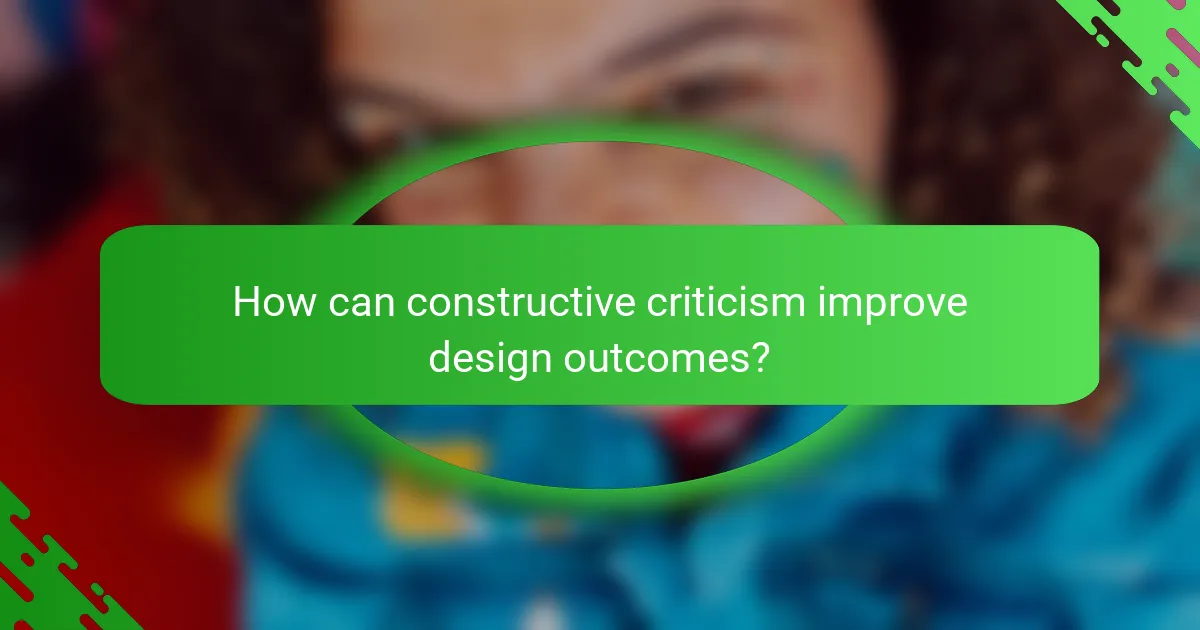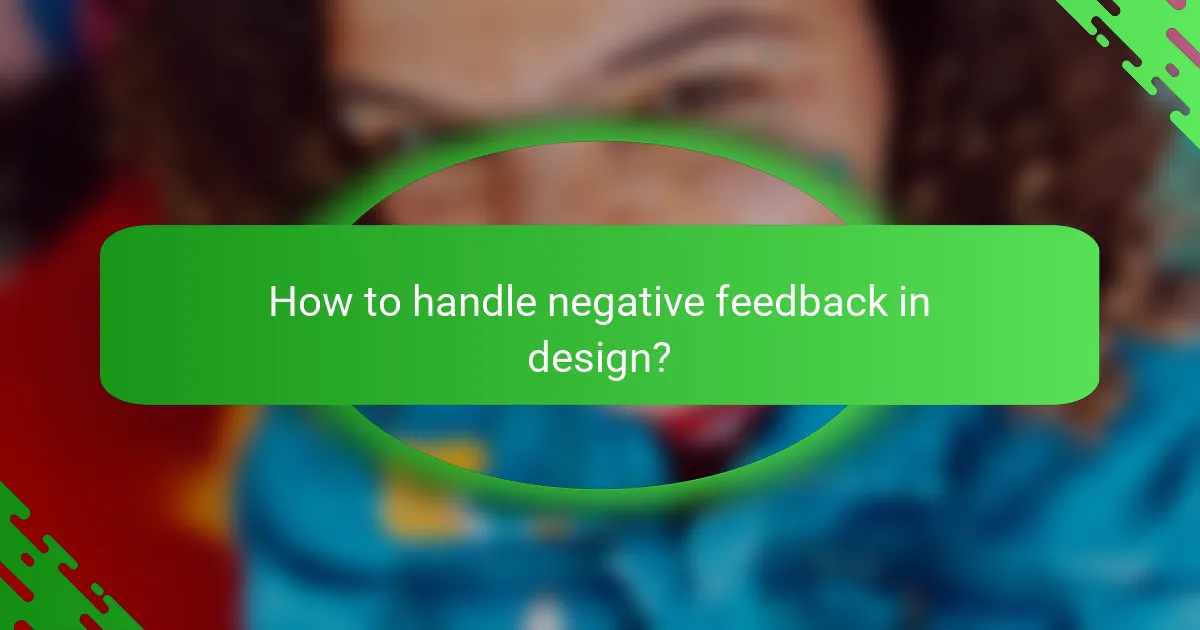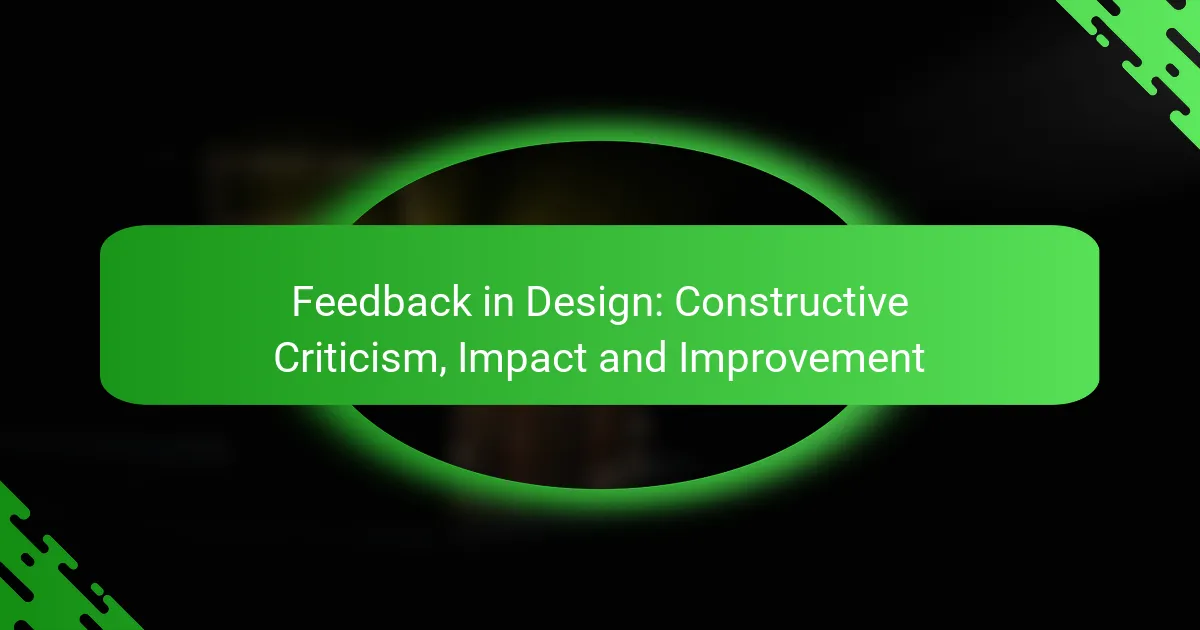Feedback plays a crucial role in the design process, as it provides valuable insights that can drive improvements and enhance overall quality. Constructive criticism not only highlights strengths and weaknesses but also fosters a culture of continuous improvement, ensuring designs are more user-centered and effective. By employing structured feedback methods, designers can facilitate clearer communication and encourage innovation, ultimately leading to better design outcomes.

How can constructive criticism improve design outcomes?
Constructive criticism can significantly enhance design outcomes by providing actionable feedback that identifies strengths and weaknesses in a project. This type of feedback fosters a culture of continuous improvement, leading to more effective and user-centered designs.
Enhances user experience
Constructive criticism directly contributes to a better user experience by highlighting areas where designs may fall short of user needs. By gathering feedback from actual users or stakeholders, designers can identify pain points and preferences, allowing for adjustments that make the final product more intuitive and satisfying.
For example, usability testing sessions can reveal how real users interact with a design, leading to insights that improve navigation or accessibility. Regularly incorporating user feedback can help ensure that the design remains aligned with user expectations and usability standards.
Increases team collaboration
Constructive criticism fosters an environment of open communication among team members, which is essential for collaboration. When team members feel comfortable sharing their thoughts, it encourages diverse perspectives and ideas, ultimately leading to more robust design solutions.
To facilitate this, teams can implement regular feedback sessions or design critiques, where everyone has the opportunity to voice their opinions. This practice not only strengthens team dynamics but also helps in identifying potential issues early in the design process.
Drives innovation
Constructive criticism can be a catalyst for innovation by challenging existing ideas and encouraging creative thinking. When designers receive feedback that pushes them to rethink their approaches, it can lead to unique solutions that may not have been considered otherwise.
For instance, brainstorming sessions that incorporate critical feedback can inspire new concepts or features that enhance the design. Embracing a mindset that views criticism as an opportunity for growth can significantly elevate the quality and originality of design outcomes.

What are effective methods for giving feedback in design?
Effective methods for giving feedback in design include structured approaches that enhance clarity and understanding. Utilizing techniques like the “sandwich” method, focusing on specific elements, and encouraging open dialogue can significantly improve the feedback process.
Use the “sandwich” method
The “sandwich” method involves framing criticism between two positive comments. This approach helps to soften the impact of negative feedback and makes it easier for the recipient to accept and act on the suggestions. For example, start with praise for a strong aspect of the design, followed by constructive criticism, and conclude with another positive note.
This method not only promotes a more positive atmosphere but also encourages the designer to remain open to feedback. However, ensure that the positive comments are genuine and relevant to avoid sounding insincere.
Focus on specific elements
When providing feedback, concentrate on specific elements of the design rather than general impressions. This could include aspects like color choices, typography, layout, or user experience features. For instance, instead of saying “this design doesn’t work,” specify that “the color contrast makes it hard to read the text.”
Specific feedback allows designers to understand exactly what needs improvement and why. It can be helpful to use visual examples or reference design principles to support your points, making the feedback more actionable.
Encourage open dialogue
Creating an environment for open dialogue fosters better communication and collaboration. Encourage designers to ask questions and express their thoughts on the feedback provided. This two-way conversation can lead to deeper insights and a more refined design outcome.

How does feedback impact design processes?
Feedback significantly influences design processes by identifying areas for improvement and ensuring alignment with user needs. Constructive criticism fosters innovation and enhances the overall quality of the design, leading to more effective outcomes.
Reduces design flaws
Incorporating feedback helps to identify and rectify design flaws early in the process. By gathering input from various stakeholders, designers can pinpoint issues that may not be apparent during initial development, reducing the risk of costly revisions later.
For example, user testing sessions can reveal usability problems that designers can address before finalizing the product. This proactive approach often leads to a more polished and functional design.
Aligns project goals
Feedback ensures that the design aligns with the project’s objectives and stakeholder expectations. Regular check-ins and reviews allow teams to adjust their direction based on collective insights, keeping the project on track.
Establishing clear criteria for feedback can help maintain focus on key goals. For instance, using a checklist of project objectives during review meetings can streamline discussions and clarify priorities.
Improves stakeholder satisfaction
Actively seeking and incorporating feedback enhances stakeholder satisfaction by making them feel valued and heard. When stakeholders see their input reflected in the design, it fosters a sense of ownership and commitment to the project.
To maximize satisfaction, consider implementing regular feedback loops throughout the design process. This could involve scheduled updates or informal check-ins, ensuring that stakeholders remain engaged and informed about progress and changes.

What frameworks can guide design feedback?
Frameworks for design feedback provide structured approaches to evaluate and improve design work. They help teams articulate their thoughts clearly and ensure that critiques are constructive and actionable.
Double Diamond model
The Double Diamond model consists of two main phases: discovery and delivery. In the discovery phase, teams explore problems and gather insights, while the delivery phase focuses on developing solutions and refining designs.
When providing feedback within this framework, emphasize the importance of both divergent and convergent thinking. Encourage team members to explore various ideas before narrowing down to the most promising solutions. This can lead to more innovative outcomes.
Common pitfalls include rushing through the discovery phase or failing to revisit initial insights during delivery. Ensure that feedback sessions allow ample time for exploration and reflection.
Design Thinking approach
The Design Thinking approach emphasizes empathy, ideation, and prototyping. It encourages designers to understand user needs deeply and iterate on solutions based on user feedback.
Incorporating feedback in this framework involves continuous testing and refinement. Use techniques like user interviews and usability testing to gather insights, and ensure that feedback loops are integrated throughout the design process.
To maximize effectiveness, avoid focusing solely on aesthetics; instead, prioritize functionality and user experience. Regularly revisit user feedback to align design decisions with user expectations and needs.

How to handle negative feedback in design?
Handling negative feedback in design involves maintaining a constructive mindset and using the input to improve your work. Embrace criticism as an opportunity for growth and refinement rather than a personal attack.
Stay objective
Staying objective means separating personal feelings from the feedback received. Focus on the specific points raised rather than interpreting them as a reflection of your abilities. This approach allows you to analyze the feedback critically and determine its validity.
Consider keeping a feedback journal where you document comments and your responses. This can help you identify patterns in the feedback and assess whether certain issues are recurring across different projects.
Seek clarification
If feedback is vague or unclear, don’t hesitate to ask for more details. Engaging in a dialogue can provide insights that may not be immediately apparent. Ask specific questions about what aspects of your design were problematic and why.
For example, instead of asking, “What do you think?” you might ask, “Can you explain which elements you found confusing?” This targeted approach can lead to more actionable insights.
Implement changes constructively
Once you have understood the feedback, prioritize the changes that will have the most significant impact on your design. Create a plan for implementing these adjustments, focusing on enhancing user experience and meeting project goals.
Keep in mind that not all feedback will be relevant or necessary to act upon. Evaluate each piece of criticism against your design objectives and user needs. A good practice is to categorize feedback into ‘must-haves’, ‘nice-to-haves’, and ‘not applicable’ to streamline your implementation process.

What are common pitfalls in design feedback?
Common pitfalls in design feedback include vague comments that lack actionable insights and an overreliance on personal preferences rather than objective criteria. These issues can hinder the design process and lead to miscommunication between designers and stakeholders.
Lack of specificity
A lack of specificity in feedback can result in confusion and frustration for designers. When comments are too general, such as “I don’t like this,” they do not provide clear guidance on what needs to change. Instead, feedback should focus on particular elements, such as color choices, layout, or functionality.
To improve specificity, consider using the “what, why, and how” approach. For instance, instead of saying “this button doesn’t work,” specify “the button’s color blends with the background, making it hard to see.” This clarity helps designers understand the exact issue and how to address it.
Overemphasis on personal taste
Overemphasizing personal taste can skew feedback away from user-centered design principles. When feedback is rooted in individual preferences rather than the needs of the target audience, it may lead to designs that do not resonate with users. It’s essential to balance personal opinions with data-driven insights.
To mitigate this pitfall, encourage feedback that is supported by user research or design principles. For example, instead of stating “I prefer blue,” frame it as “blue aligns with our brand identity and appeals to our target demographic.” This approach grounds feedback in broader objectives rather than subjective tastes.



